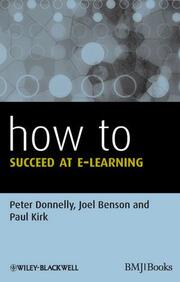Detailansicht
How to Succeed at e-Learning
HOW - How To
ISBN/EAN: 9780470670231
Umbreit-Nr.: 3204641
Sprache:
Englisch
Umfang: 160 S.
Format in cm:
Einband:
kartoniertes Buch
Erschienen am 06.07.2012
Auflage: 1/2012
- Zusatztext
- With undergraduate and postgraduate curricula increasingly delivered or supported by electronic means, it is time for both learners and teachers to develop the specific skills that are essential to successful e-learning, but seldom taught in medical school. This concise guide, based on the authors' experience in e-learning, is accessible to any novice and supplies a basic grounding in using technology to learn, to teach, and to conduct research.
- Kurztext
- A basic guide to getting the best from e-learning for medical students, teachers and all healthcare professionals With undergraduate and postgraduate curricula, and continuing medical education increasingly delivered and supported by electronic means, it is vital that both learners and teachers develop the specific skills that are essential to successful e-learning. Based on the expert author team's experience in e-learning, this concise guide is accessible to any novice and with examples of technology in use, it supplies a basic grounding in using technology to learn, teach, and conduct research. How to Succeed at E-learning answers the needs of all healthcare professionals either starting or continuing their studies but not knowing where to begin with e-learning. It is a valuable guide for learners in undergraduate and postgraduate medicine as well as related health professionals and essential for teachers of medicine who are beginning to transfer from print to electronic teaching and need to understand effective methods of presentation.
- Autorenportrait
- InhaltsangabeAcknowledgements, ix Chapter 1: Introduction, 1 1.1 Overview of the book, 1 1.2 Basic issues, 1 1.3 Challenges as drivers, 2 1.4 The start of technology in learning, 2 Reference, 4 Chapter 2: Elearning. what is it?, 5 2.1 Definitions, 5 2.2 Advantages of e-learning, 24 References, 26 Chapter 3: Evidence e-learning works, 29 3.1 Systematic reviews, 29 3.2 Examples of subject-specific studies (categorised by profession), 33 3.3 Summary of findings, 36 3.4 Conclusion, 37 References, 37 Chapter 4: Using e-learning to teach, 41 4.1 Requirement, 42 4.2 Exploration, 54 4.3 The course, 63 4.4 The assessment, 66 4.5 Choosing a platform, 67 4.6 Summary, 68 References, 68 Chapter 5: Access to e-learning, 71 5.1 The basics: files and folders, 71 5.2 Security, 72 5.3 The book and the browser, 73 5.4 Collaborative research, 76 References, 80 Chapter 6: Examples of technology in use, 83 6.1 A Taste of Medicine, 83 6.2 Examples of innovative e-learning from developing countries, 85 6.3 Examples from developed countries, 92 References, 93 Chapter 7: Elearning qualifications, 95 7.1 What to look for in an online course, 96 7.2 Clinical courses, 98 7.3 Leadership courses, 106 7.4 Management courses, 109 7.5 General information on internationally available online MBAs, 113 7.6 Mentoring courses, 114 7.7 Legal courses, 117 References, 120 Chapter 8: Research, 123 8.1 Just in time, just enough and on the move, 123 8.2 What is virtual reality (VR)?, 124 8.3 Virtual reality systems in medicine, 125 8.4 VR in obstetrics and gynaecology, 125 8.5 Lifesize patient simulators, 127 8.6 Other simulation examples, 128 8.7 Wholeheart modelling, 129 8.8 Telling stories: understanding real-life genetics, 129 8.9 Second Life VR, 129 References, 133 Chapter 9: Looking towards the future, 135 9.1 The recent past, 135 9.2 Why is 'computing power' important and how is it defined?, 137 9.3 Past trends informing future trends, 137 9.4 Experiments involving neurosurgical implants, 139 9.5 Ongoing development in mobile technology, 140 9.6 Summary, 141 References, 141 Chapter 10: Conclusion, 143 Index, 147
